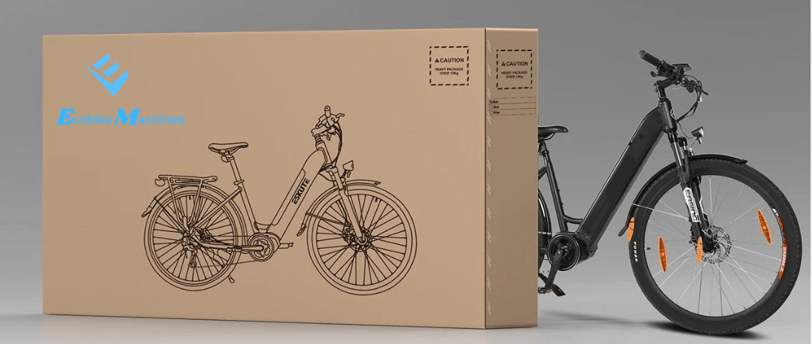Turn Every Ride Into an Adventure, Your Electric Freedom Awaits! 🚴♂️⚡ SHOP NOW! 🌍🚀
How Electric Bikes are Revolutionizing Delivery Services


Introduction to Electric Bikes in Delivery
Electric bikes, commonly known as e-bikes, are a type of bicycle that is equipped with an electric motor, providing assistance to the rider. This innovative mode of transportation combines the traditional pedaling experience with battery-powered propulsion, allowing riders to cover greater distances and tackle challenging terrains with ease. E-bikes come in various models, including cargo bikes designed specifically for transporting goods, making them an appealing choice for delivery services.
The growing popularity of electric bikes in urban environments can be attributed to several factors. Firstly, the increasing congestion and traffic in cities have led many businesses to seek alternative delivery methods that are efficient and environmentally friendly. E-bikes offer a practical solution, allowing delivery personnel to navigate through narrow streets and avoid traffic jams. Additionally, e-bikes emit no greenhouse gases during operation, contributing to the reduction of urban pollution and aligning with the global shift towards sustainable practices.
Highly versatile, e-bikes can be employed for various delivery services, ranging from food and groceries to packages and documents. Their ability to easily access areas that may be challenging for traditional motor vehicles ensures that deliveries can be made promptly and effectively. Battery life and charging infrastructure have also improved significantly, enabling delivery riders to complete long routes without concern for running out of power.
The integration of electric bikes into the delivery sector signifies a transformative step towards more sustainable logistics. As businesses increasingly recognize the benefits of e-bikes, both for operational efficiency and environmental impact, the adoption of this technology is poised to reshape the landscape of delivery services in urban areas.
Environmental Impact of E-Bikes
Electric bikes (e-bikes) have emerged as a transformative option in the delivery sector, presenting numerous environmental advantages over traditional delivery vehicles. One of the most significant benefits is the substantial reduction in carbon emissions. Conventional delivery trucks and vans often rely on fossil fuels, contributing heavily to greenhouse gas emissions. In contrast, e-bikes operate using electric power, dramatically lowering the carbon footprint associated with transportation. This reduction is especially pronounced in urban areas where traffic congestion and pollution levels are high, emphasizing the potential for e-bikes to foster cleaner delivery alternatives.
Moreover, e-bikes occupy a smaller physical footprint on the road, facilitating more efficient delivery routes that reduce traffic congestion. This not only helps in minimizing emissions but also leads to reduced idle times, further contributing to lower overall fuel consumption. Additionally, as cities continuously evolve to meet sustainability goals, the integration of e-bikes in the delivery ecosystem aligns seamlessly with efforts to create environmentally friendly urban spaces. Traditional delivery methods often lead to road degradation and increased maintenance costs for urban infrastructure. With e-bikes, the impact on roads is significantly lessened, thereby reducing the need for frequent repairs and preserving city budgets.
Furthermore, the utilization of e-bikes can lead to improved air quality in densely populated areas. By decreasing reliance on gas-powered vehicles, e-bikes help to mitigate air pollution, which can have detrimental effects on public health. Cities adopting e-bikes for deliveries can witness a notable improvement in community well-being, with reduced respiratory issues related to poor air quality. The shift toward e-bikes not only represents a step forward in enhancing delivery efficiency but also reinforces commitment to environmental stewardship, showcasing a responsible approach to urban transport solutions.
Cost-Effectiveness for Delivery Businesses
Electric bikes (e-bikes) have emerged as a cost-effective solution for delivery businesses, enabling them to reduce operational costs significantly. One of the primary financial benefits of e-bikes is their low maintenance requirements compared to traditional delivery vehicles. E-bikes typically have fewer moving parts, resulting in less wear and tear, which translates to lower repair bills and reduced downtime.
Fuel costs are another substantial area where delivery companies can save money by switching to e-bikes. With rising fuel prices, e-bikes provide an economical alternative, as they are powered by electricity, which is considerably cheaper per mile than gasoline. Furthermore, many urban areas are investing in charging infrastructure, making it more convenient for delivery businesses to keep their e-bikes charged and ready for use.
The potential for increased delivery efficiency also contributes to the cost-effectiveness of electric bikes. With their ability to navigate through congested city streets and access pedestrian areas, e-bikes can often reach customers faster than traditional vehicles stuck in traffic. For instance, companies like Domino's Pizza have successfully integrated e-bikes into their delivery fleet, reporting enhanced speed of delivery while significantly cutting transportation costs.
Moreover, e-bikes promote sustainable delivery practices, reducing the carbon footprint associated with delivery operations. By adopting e-bikes, delivery companies not only enjoy economic advantages but also align their operations with growing environmental concerns, appealing to an eco-conscious customer base. Businesses such as Postmates and Foodpanda have observed improved customer satisfaction and loyalty since implementing e-bikes, further solidifying the financial benefits of this emerging trend.
In conclusion, the integration of electric bikes into delivery fleets provides substantial cost savings, lower maintenance expenses, reduced fuel costs, and enhanced operational efficiency. As more delivery companies recognize these advantages, e-bikes will continue to revolutionize the delivery service industry.
Improving Delivery Efficiency
Electric bikes, or e-bikes, offer significant enhancements in delivery efficiency, particularly in urban landscapes where congestion is prevalent. The lightweight and compact design of e-bikes allows for superior maneuverability, enabling them to weave through traffic with ease. This capability drastically reduces delivery times, as e-bike riders can often avoid the standstill that characterizes traditional vehicular traffic.
One of the standout advantages of e-bikes is their ability to navigate urban environments seamlessly. When conventional delivery vehicles are confronted with blocked streets or congested thoroughfares, e-bikes can take alternate routes, such as bicycle paths or narrower streets, thus minimizing delays. This flexibility not only optimizes delivery times but also ensures that packages reach their destinations more promptly. Moreover, e-bikes support quicker response times for urgent deliveries, enhancing the overall service level provided by delivery companies.
Furthermore, e-bikes alleviate the common challenge of finding parking in busy urban areas. Traditional delivery vans often struggle with limited parking availability, which can cause additional delays and complications for drivers. E-bikes, however, can park virtually anywhere a regular bicycle can, allowing for faster unloading of goods. This reduces the time spent circling for parking and increases the number of deliveries a rider can complete within a given timeframe.
As a result of these efficiencies, customer satisfaction often improves significantly. The combination of speed, reliability, and reduced carbon footprint translates into a more positive experience for customers. Timely deliveries contribute to a perception of quality service, fostering loyalty and encouraging businesses to switch to electric bike delivery systems. Thus, e-bikes are not just a mode of transport; they are a transformative solution for enhancing delivery operations in today's fast-paced economy.
Technological Advancements in E-Bikes
The landscape of electric bikes (e-bikes) has witnessed tremendous innovations over recent years, particularly in battery technology, GPS tracking, and smart features. These advancements have significantly enhanced the practicality and appeal of e-bikes, particularly for delivery services.
Battery technology has undergone significant improvements, leading to lighter, more efficient, and longer-lasting power sources. Modern lithium-ion batteries offer extended ranges, allowing delivery services to cover greater distances without the frequent need for recharging. This capability is critical for logistics, as unpredictable battery life can impede the timely delivery of goods. Additionally, advancements in charging infrastructure mean that e-bikes can be powered up rapidly during short breaks, further optimizing delivery times.
GPS tracking is another crucial development that contributes to the efficiency of e-bike delivery services. With real-time tracking capabilities, companies can monitor their delivery staff's locations and the status of their shipments. This level of oversight allows for better route optimization, reducing delivery times and improving customer satisfaction. Customers also benefit from the ability to track their orders in real time, which enhances transparency and builds trust in the service.
Moreover, e-bikes are becoming increasingly equipped with smart features that elevate user experience. Features such as integrated navigation systems, mobile app connectivity, and updated safety mechanisms like automatic lights and horns all contribute to making e-bikes more user-friendly. These enhancements ensure that delivery personnel can navigate urban environments safely and efficiently, adapting their routes based on current traffic conditions. As such, the technological advancements in e-bikes play a pivotal role in not only improving the delivery services but also making e-bike usage a practical choice for businesses in the logistics industry.
Case Studies of Successful Implementation
Electric bikes have emerged as a sustainable alternative in various sectors, revolutionizing delivery services with efficiency and reduced carbon footprints. Notable case studies exemplify how companies have successfully integrated e-bikes into their operations. One prominent example is Domino's Pizza in the United Kingdom. The company introduced e-bikes in select cities, significantly improving delivery times and reducing dependence on motor vehicles. By utilizing e-bikes, the company not only enhanced its operational efficiency but also appealed to environmentally-conscious consumers, showcasing a commitment to sustainability.
Another insightful case is evidenced by the logistics giant DHL. This global leader in the logistics sector began utilizing electric bikes for urban deliveries in several cities across Europe. The deployment of e-bikes has led to quicker navigational capabilities in congested urban areas, resulting in reduced delivery times. Additionally, DHL reported a decrease in operational costs associated with fuel and maintenance of conventional delivery vehicles. This initiative demonstrates the adaptability of electric bikes in large-scale logistics operations.
Moreover, local businesses have also benefitted from implementing e-bikes. For instance, a grocery delivery service called “Grocery Delivery Express,” based in California, integrated electric bikes into their fleet, facilitating same-day delivery offerings while minimizing grocery spoilage and inefficiencies. The use of e-bikes allowed the service to maintain competitive pricing in a bustling market, while also emphasizing their dedication to green practices.
These examples illustrate the diverse applications of electric bikes across industries. From food delivery to large-scale logistics and local services, e-bikes have proven their effectiveness in enhancing delivery operations. The mix of faster deliveries, lower costs, and sustainability underscores why electric bikes are becoming increasingly popular in the modern delivery landscape.
The Future of Delivery Services with E-Bikes
The integration of electric bikes into delivery services is set to transform the logistics landscape significantly. As urban areas continue to grapple with congestion and environmental concerns, e-bikes present an efficient solution that promotes sustainability. The forecast indicates a sharp increase in e-bike adoption, driven by their ability to navigate crowded streets, reduce emissions, and offer lower operational costs compared to traditional delivery vehicles.
In the coming years, regulatory frameworks are expected to adapt to the growth of e-bike utilization in delivery services. Policymakers are recognizing the importance of encouraging electric mobility, providing incentives to businesses that adopt these environmentally friendly options. This shift could include designated e-bike lanes, parking facilities, and subsidies supporting e-bike purchases and infrastructure development. As regulations evolve, delivery companies may increasingly explore ways to optimize their logistics networks, integrating e-bikes alongside cars, vans, and public transport options. This multi-modal approach will enhance efficiency and service flexibility.
Another emerging trend is the collaboration between companies and local governments to create smart urban environments that support e-bike deliveries. By utilizing data-driven insights, companies can enhance route planning, optimize delivery times, and effectively deploy their fleet in real-time. Furthermore, the synergies between electric bikes and advancements in technology, such as delivery drones and automated tracking systems, will foster a comprehensive approach to urban mobility solutions.
The shift towards electric bike delivery services signifies not just a change in logistics but also a broader reimagining of urban transport. In summary, the future of delivery services with e-bikes appears promising, with advancements in technology, supportive regulations, and an increased focus on sustainability culminating in a transformative impact on how goods are transported in urban areas.
Address:
999 Charlotte Hwy, NC 28730, USA
Sales:
Email: sales@ecobikemachines.com
Call: (863) 272-9235
Subscribe to our newsletter
COMPANY
Online Support:
Email: support@ecobikemachines.com
Call: (626) 686-4545
